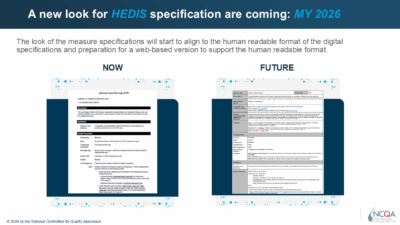Coming August 1: A New Look for HEDIS!
July 15, 2025 · Becky Kolinski
Earlier this year, we announced updates to the HEDIS® MY 2026 Volume 2: Technical Specifications for Health Plans publication to support the transition to digital HEDIS measurement. As the August 1 release date approaches, we’re sharing details and resources to help organizations get comfortable with the changes.
“We’re evolving the HEDIS publication to advance how the information can be accessed and reflect how users want to engage with it,” says NCQA’s Taylor Musser, Director, Measure and Data Operations. “This refresh incorporates feedback from our customers and partners, and continues our commitment in aligning with data standards for interoperability.”
Redesigning HEDIS Volume 2 to Support Digital Measurement
A new approach to the human-readable specifications in the HEDIS Volume 2 publication is an essential step along the path toward digital quality measurement. The narratives will align with the FHIR® measure resource to support a future where health plans, providers, public agencies, vendors and all other HEDIS users can access and view HEDIS measures in the same format—in any system they use.

The new look enables the narratives to stand on their own and better resonate with how HEDIS measures are used—from evaluating health plan performance, to promoting quality improvement at the point of care, to identifying health care needs in a population.
What’s Changing?
The human-readable specifications have a new structure and format similar to current HEDIS ECDS reported measures. Users will have all the information they need to calculate a HEDIS measure, in addition to these updates:
- Integration of a measure’s clinical evidence-base and general guidelines, reducing the need to reference multiple resources.
- Adoption of new terms, for consistency with the FHIR measure resource, that reflect how measures are used. For example:
-
- We replaced “eligible population” with initial population.
- We replaced “required exclusions” with denominator exclusions.
- We replaced “measurement year” with measurement period.
- We replaced “member” with person.
What’s Not Changing?
We have not modified the measures’ intent or requirements. The changes should not affect performance results.
Updates to HEDIS Volume 1
“An unwieldy document is not how people consume content these days,” says Musser. “By distributing this content in smaller pieces across multiple channels, we’re adapting to meet individuals’ preferences for how they receive this information.”
We made the following changes to HEDIS Volume 1: Narrative:
- Clinical practice guidelines and justifications for each measure are now part of the measure specifications in HEDIS Volume 2.
- We’re updating The State of Health Care Quality Report on our website to include information from the latest release of the HEDIS measure set, with user-friendly descriptions of new measures.
- Information about the history of HEDIS, and why HEDIS measures are important for quality measurement, will be part of a new online education course to be released later this year.
Your Next Steps
It may take some time to adapt to these changes. We recommend you start conversations with your internal team, customers and vendors to make sure everyone is aligned. Here are some resources that can help.
- View a sample HEDIS measure in the new format.
- Preorder the HEDIS Volume 2 publication, which releases August 1.
- Stay tuned for our new HEDIS 101 education course, coming soon.
- Visit the Digital Quality Hub to learn about the transition to digital quality.







